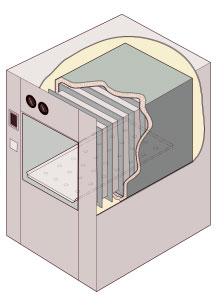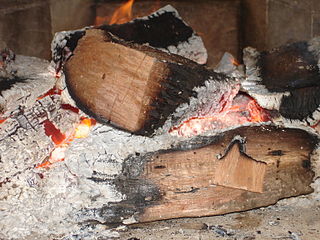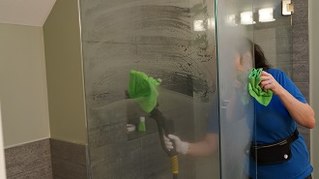
A kiln is a thermally insulated chamber, a type of oven, that produces temperatures sufficient to complete some process, such as hardening, drying, or chemical changes. Kilns have been used for millennia to turn objects made from clay into pottery, tiles and bricks. Various industries use rotary kilns for pyroprocessing and to transform many other materials.

An autoclave is a machine used to carry out industrial and scientific processes requiring elevated temperature and pressure in relation to ambient pressure and/or temperature. Autoclaves are used before surgical procedures to perform sterilization and in the chemical industry to cure coatings and vulcanize rubber and for hydrothermal synthesis. Industrial autoclaves are used in industrial applications, especially in the manufacturing of composites.

The pyrolysis process is the thermal decomposition of materials at elevated temperatures, often in an inert atmosphere. The word is coined from the Greek-derived elements pyro "fire", "heat", "fever" and lysis "separating".

Gasification is a process that converts biomass- or fossil fuel-based carbonaceous materials into gases, including as the largest fractions: nitrogen (N2), carbon monoxide (CO), hydrogen (H2), and carbon dioxide (CO2). This is achieved by reacting the feedstock material at high temperatures (typically >700 °C), without combustion, via controlling the amount of oxygen and/or steam present in the reaction. The resulting gas mixture is called syngas (from synthesis gas) or producer gas and is itself a fuel due to the flammability of the H2 and CO of which the gas is largely composed. Power can be derived from the subsequent combustion of the resultant gas, and is considered to be a source of renewable energy if the gasified compounds were obtained from biomass feedstock.

Brazing is a metal-joining process in which two or more metal items are joined by melting and flowing a filler metal into the joint, with the filler metal having a lower melting point than the adjoining metal.

An oven is a tool which is used to expose materials to a hot environment. Ovens contain a hollow chamber and provide a means of heating the chamber in a controlled way. In use since antiquity, they have been used to accomplish a wide variety of tasks requiring controlled heating. Because they are used for a variety of purposes, there are many different types of ovens. These types differ depending on their intended purpose and based upon how they generate heat.

In electrical and safety engineering, hazardous locations are places where fire or explosion hazards may exist. Sources of such hazards include gases, vapors, dust, fibers, and flyings, which are combustible or flammable. Electrical equipment installed in such locations can provide an ignition source, due to electrical arcing, or high temperatures. Standards and regulations exist to identify such locations, classify the hazards, and design equipment for safe use in such locations.

Powder coating is a type of coating that is applied as a free-flowing, dry powder. Unlike conventional liquid paint which is delivered via an evaporating solvent, powder coating is typically applied electrostatically and then cured under heat or with ultraviolet light. The powder may be a thermoplastic or a thermoset polymer. It is usually used to create a hard finish that is tougher than conventional paint. Powder coating is mainly used for coating of metals, such as household appliances, aluminium extrusions, drum hardware, automobiles, and bicycle frames. Advancements in powder coating technology like UV-curable powder coatings allow for other materials such as plastics, composites, carbon fiber, and MDF to be powder coated due to the minimum heat and oven dwell time required to process these components.
In metallurgy and materials science, annealing is a heat treatment that alters the physical and sometimes chemical properties of a material to increase its ductility and reduce its hardness, making it more workable. It involves heating a material above its recrystallization temperature, maintaining a suitable temperature for an appropriate amount of time and then cooling.
Laboratory ovens are a common piece of equipment that can be found in electronics, materials processing, forensic, and research laboratories. These ovens generally provide pinpoint temperature control and uniform temperatures throughout the heating process. The following applications are some of the common uses for laboratory ovens: annealing, die-bond curing, drying or dehydrating, Polyimide baking, sterilizing, evaporating. Typical sizes are from one cubic foot to 0.9 cubic metres (32 cu ft). Some ovens can reach temperatures that are higher than 300 degrees Celsius. These temperatures are then applied from all sides of the oven to provide constant heat to sample.
Burn-in ovens in electronics device fabrication, are designed for dynamic and static burn-in of integrated circuits and other electronic devices, including laser diodes. Typical sizes are from under ten to over 30 cubic feet (0.85 m3), with air or nitrogen configurations. Operating temperatures can go over 260 °C (500 °F), and can use both single and multiple temperature settings.
Reach-in ovens are meant for different industrial applications that may need uniform temperature throughout. The ovens normally use horizontal re-circulating air to ensure the uniform temperature, and can use fans that circulate air, creating the airflow. Reach-in ovens can be used in numerous production and laboratory applications, including curing, drying, sterilizing, aging, and other process-critical applications.
Batch ovens are a type of furnace used for thermal processing. They are used in numerous production and laboratory applications, including curing, drying, sterilizing, aging, and other process-critical applications. Sizes can vary depending on what type of thermal processing application is needed. Batch ovens are used mainly for single batch thermal processing. Cabinet and bench ovens are smaller batch ovens, and walk in/drive in ovens are larger and to be used for more variations of industrial applications.

Industrial ovens are heated chambers used for a variety of industrial applications, including drying, curing, or baking components, parts or final products. Industrial ovens can be used for large or small volume applications, in batches or continuously with a conveyor line, and a variety of temperature ranges, sizes and configurations.
Induction brazing is a process in which two or more materials are joined together by a filler metal that has a lower melting point than the base materials using induction heating. In induction heating, usually ferrous materials are heated rapidly from the electromagnetic field that is created by the alternating current from an induction coil.

Steam cleaning involves using steam for cleaning. Its uses include domestic applications in cleaning flooring and household dirt removal, and industrial uses in removing grease and dirt from engines.

Parchment paper, vegetable parchment, or, baking paper is a cellulose-based composite that has been processed to give it additional properties like non-stickiness, grease resistance, and resistance to humidity. It is commonly used in baking as a disposable non-stick, grease resistant surface. It should not be confused with waxed paper, which is paper that has been coated in wax.
Thermal cleaning is a combined process involving pyrolysis and oxidation. As an industrial application, thermal cleaning is used to remove organic substances such as polymers, plastics and coatings from parts, products or production components like extruder screws, spinnerets and static mixers. Thermal cleaning is the most common cleaning method in industrial environment. A variety of different methods have been developed so far for a wide range of applications.

An industrial furnace, also known as a direct heater or a direct fired heater, is a device used to provide heat for an industrial process, typically higher than 400 degrees Celsius. They are used to provide heat for a process or can serve as reactor which provides heats of reaction. Furnace designs vary as to its function, heating duty, type of fuel and method of introducing combustion air. Heat is generated by an industrial furnace by mixing fuel with air or oxygen, or from electrical energy. The residual heat will exit the furnace as flue gas. These are designed as per international codes and standards the most common of which are ISO 13705 / American Petroleum Institute (API) Standard 560. Types of industrial furnaces include batch ovens, metallurgical furnaces, vacuum furnaces, and solar furnaces. Industrial furnaces are used in applications such as chemical reactions, cremation, oil refining, and glasswork.











